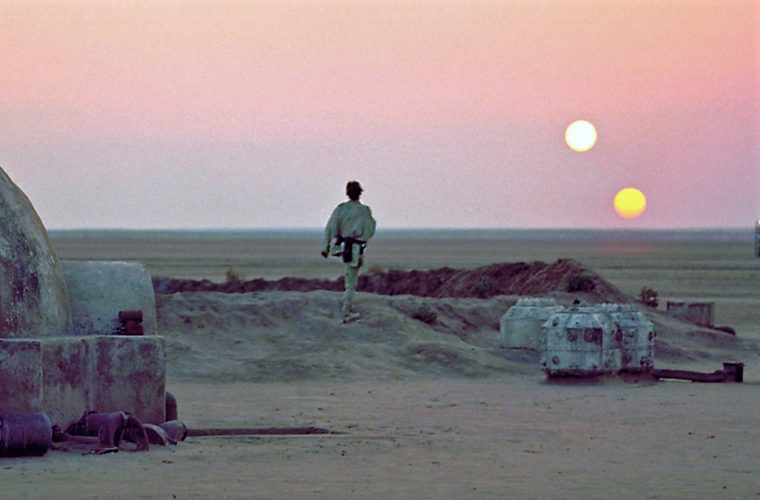For fans of the 1977 landmark science fiction film Star Wars, few if any scenes are as iconic or as breathtaking as Luke Skywalker gazing into the Tatooine evening sky at a pair of alien suns setting on the horizon.
Now, by using a newly-developed mathematical framework, a team of researchers from New York University, Abu Dhabi, and the University of Washington have shown that unlike previously thought, binary star systems (systems with two stars orbiting each other) just like the one that captured audiences’ imaginations a long, long time ago, may indeed be home to habitable, Earth-like planets after all.
Background: A New Hope
Published in the journal Frontiers in Astronomy and Space Sciences, the researchers analyzed nine binary star systems previously identified by the Kepler mission as hosting giant planets at least as large as Neptune.
“Life is far most likely to evolve on planets located within their system’s Habitable Zone, just like Earth,” said study co-author Dr. Nikolaos Georgakarakos, a research associate from the Division of Science at New York University, Abu Dhabi, in the press release announcing the results.
Of course, many of the over 4,000 already identified exo-planets orbit a single star, including a group of rocky, Earth-like planets orbiting the star Trappist-1. Four of those appear to lie within their host star’s habitable zone, where liquid water could theoretically exist on the planet’s surface, already making them targets for future NASA missions.
Still, regardless of star system type, most of the alien worlds we have discovered are giants, meaning they likely have little to no chance of harboring life, at least not life as we know it.
Therefore, given the many challenges already present in searching for a theoretical “second Earth,” the folks who undertake these types of studies have mostly avoided searching for planets around binary star systems like the one Luke Skywalker called home. Instead, they focused on systems with only one star like our own solar system, where we know at least one planet harbors life.
Analysis: Can Binary Star Systems Support Life?
Several factors, including the effects of two stars worth of gravity and radiation, led to this determination. However, the study authors note, “binary systems are common, estimated to represent between half and three-quarters of all star systems.”
It was this surplus of star systems previously deemed unlikely to harbor habitable planets, specifically binary systems previously determined to have at least one giant planet in orbit, that led the research team to take another look, ultimately zeroing in on nine systems identified by Kepler as fitting this particular type.
Once those candidates were selected, the team had to consider each star’s type, mass, luminosity, and most notably, stellar radiation and gravity.
“Some of the challenges in assessing habitability in binary star systems arises from the fact that one has to account for two sources of radiation, possibly of different spectral type,” the study explains. “The second star provides an additional source of radiation, and more importantly, it is also a source of gravitational perturbations for the planetary orbit.”
Additional elements were also factored into the team’s habitability calculation, including the gravitational effects from the system’s giant planet, any theoretically habitable planet’s orbital eccentricity and orbital period, and even something researcher’s termed a planet’s “climate inertia,” an element defined as, “the speed at which the atmosphere responds to changes in irradiation.”
Once the team had accounted for all of these variables and applied them to the data from the nine Kepler binary star systems with known planetary giants, the results indicated five of those nine systems supported extraterrestrial friendly, habitable zones.
“By applying this methodology to Kepler-16, Kepler-34, Kepler-35, Kepler-38, Kepler-64, Kepler-413, Kepler-453, Kepler-1647, and Kepler-1661,” the study explains, “we demonstrate that the presence of the known giant planets in the majority of those systems does not preclude the existence of potentially habitable worlds.”
Specifically, the team concludes of the five worthiest candidates, “Kepler-34, Kepler-35, Kepler-38, Kepler-64, and Kepler-413 seemed more promising [for habitability], with Kepler-38 being the best candidate in this respect.”
Outlook: Binary Star Systems Will Be All The Rage
Of course, as one of the study’s co-authors points out, astronomers and astrobiologists still know so little about potential life outside our planet that even such would-be Jedi Knights may not necessarily be restricted to living within our definition of a habitable zone.
“There is the possibility that life exists outside the habitable zone or on moons orbiting the giant planets themselves,” says co-author Dr. Siegfried Eggl from the University of Washington, while also still noting that “that may be less desirable real-estate for us.”
As with all exoplanet research, more data will be needed to determine if any potentially habitable planets exist in any of the five most favorable Kepler star systems. But until then, the researchers behind this study feel they have clearly proven binary star systems are not inherently uninhabitable, even if they already have a giant planet in their orbit, and therefore make viable targets in the search for another world like our own.
“Our study confirms that even binary star systems with giant planets are hot targets in the search for Earth 2.0,” says Georgakarakos, before giving one final nod to that infamous, far, far away double-sunset. “Watch out Tatooine, we are coming!”
Follow and connect with author Christopher Plain on Twitter: @plain_fiction
Don’t forget to follow us on Twitter, Facebook, and Instagram, to weigh in and share your thoughts. You can also get all the latest news and exciting feature content from The Debrief on Flipboard, and Pinterest. And subscribe to The Debrief YouTube Channel to check out all of The Debrief’s exciting original shows: The Official Debrief Podcast with Michael Mataluni– DEBRIEFED: Digging Deeper with Cristina Gomez –Rebelliously Curious with Chrissy Newton

